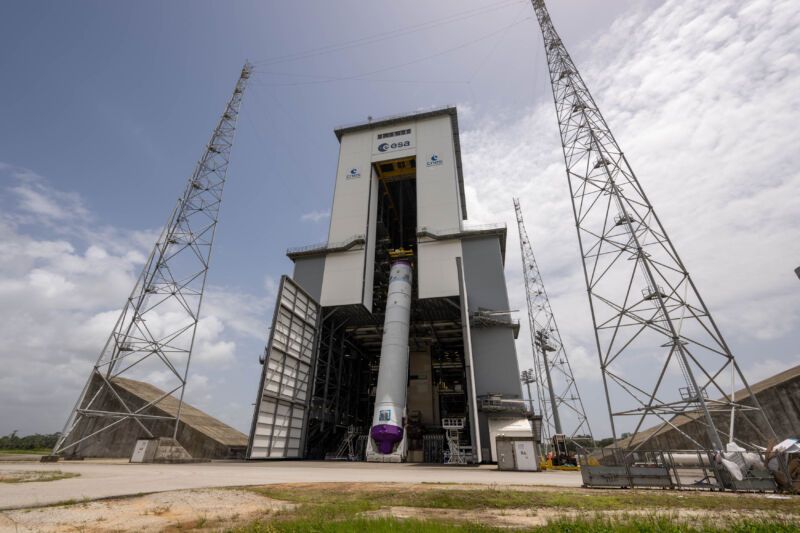
ESA-M. Pédoussaut
Welcome to Edition 6.41 of the Rocket Report! As I finish up this edition I’m listening to the post-Flight Readiness Review news conference for Boeing’s Crew Flight Test. It sounds like everything remains on track for a launch attempt on May 6, at 10:34 pm ET. It’s exciting to see this important milestone for Boeing and the US human spaceflight program so near to hand.
As always, we welcome reader submissions, and if you don’t want to miss an issue, please subscribe using the box below (the form will not appear on AMP-enabled versions of the site). Each report will include information on small-, medium-, and heavy-lift rockets as well as a quick look ahead at the next three launches on the calendar.

Shetland spaceport advancing toward launch. SaxaVord Spaceport in Scotland is on track to launch the United Kingdom’s first vertical rocket into orbit, the BBC reports. The Civil Aviation Authority has granted a range license to the Scottish spaceport, which will allow the company to control the sea and airspace during launch. Previously, the site received a spaceport license in December 2023. Ambitiously, the facility aims to launch up to 30 rockets every year.
From Germany to Scotland with love … “This is a vital component in our preparations for launch,” said Frank Strang, chief executive of SaxaVord Spaceport. “As Western Europe’s only fully licensed vertical launch spaceport, we are now preparing to make more space history with the beginning of orbital launch operations well underway.” Germany-based rocket manufacturer Rocket Factory Augsburg could be the first to launch an orbital mission from Shetland later this year. (submitted by Ken the Bin)
Rocket Lab launches 5th Electron this year. Rocket Lab launched a South Korean smallsat and a NASA solar sail experiment on the company’s fifth flight of the year on Tuesday, Space News reports. NEONSAT-1, the primary payload of the mission, is an imaging satellite with a mass of about 100 kilograms. The spacecraft is part of a constellation of 11 spacecraft called New-space Earth Observation Satellite Constellation for National Safety, with the other 10 to be launched by South Korea’s Nuri rocket in 2026 and 2027.
Better get busy … This was the first Electron launch in more than a month after a mission for the National Reconnaissance Office on March 21 from Rocket Lab’s Launch Complex 2 in Virginia. Company executives said in an earnings call in February that the company has 22 Electron launches planned for the year, two of which are of its HASTE suborbital version. That would be an impressive total if Rocket Lab can achieve it. (submitted by Jay500001)
PLD Space has raised 120 million euros. The Spanish launch startup revealed this week that it has raised 120 million euros to date, providing the funding needed to launch its orbital Miura 5 rocket by the end of 2025. Last October the company’s smaller, suborbital Miura 1 rocket made what the company characterized as a “successful” test flight, reaching an altitude of 46 km. By my very rough rule of thumb, a launch company must have at least $100 million in funding to have a fighting chance to reach orbit.
Building new buildings … The Miura 5 vehicle is intended to have a capacity of up to 250 kg in low-Earth orbit. The new funding will mainly be used for the expansion of PLD Space’s infrastructure, increasing the size of its facilities from 169,000 to 834,000 square meters. The company also plans to begin building a launch site for the Miura 5 rocket in Kourou, French Guiana, later this year. (submitted by Ken the Bin and EllPeaTea)

SpaceX lands 300th Falcon booster. With the launch of a Starlink mission on Tuesday evening and subsequent return of the Falcon 9 first stage, SpaceX recorded its 300th successful booster landing. In the Falcon fleet’s lifetime, SpaceX has now landed about 85 percent of the Falcon rockets it has launched, Ars reports. These days, more than 90 percent of all its missions launch on previously flown boosters. So, rocket recycling is totally a thing.
Saving a lot of metal … Landing 300 rockets means SpaceX has preserved 2,700 Merlin rocket engines. In round numbers, the dry mass of a Falcon 9 first stage is about 50 metric tons, so the landing of all these rockets has prevented 15,000 metric tons of metal and other materials from being dumped into the oceans. To put this number further into perspective, only a handful of rockets have ever launched more than 300 times, and they are all Russian.
China launches astronaut mission. A Long March 2F rocket lifted off from the Jiuquan Satellite Launch Center in the Gobi Desert on Thursday, carrying the Shenzhou 18 spacecraft and its three-person crew into orbit, Space.com reports. Shenzhou 18 is commanded by Ye Guangfu, 43, who was part of the Shenzhou 13 mission three years ago. Fighter pilots Li Cong, 34, and Li Guangsu, 36, both spaceflight rookies, make up the rest of the crew.
A change in control … The three will spend around six months in space. Their spacecraft is scheduled to reach the Tiangong space station 6.5 hours after launch. The trio will be greeted aboard the orbital outpost by Tang Hongbo, Tang Shengjie, and Jiang Xinlin, who make up the Shenzhou 17 crew. The latter three will soon complete their six months in orbit. (submitted by Ken the Bin and EllPeaTea)




















+ There are no comments
Add yours